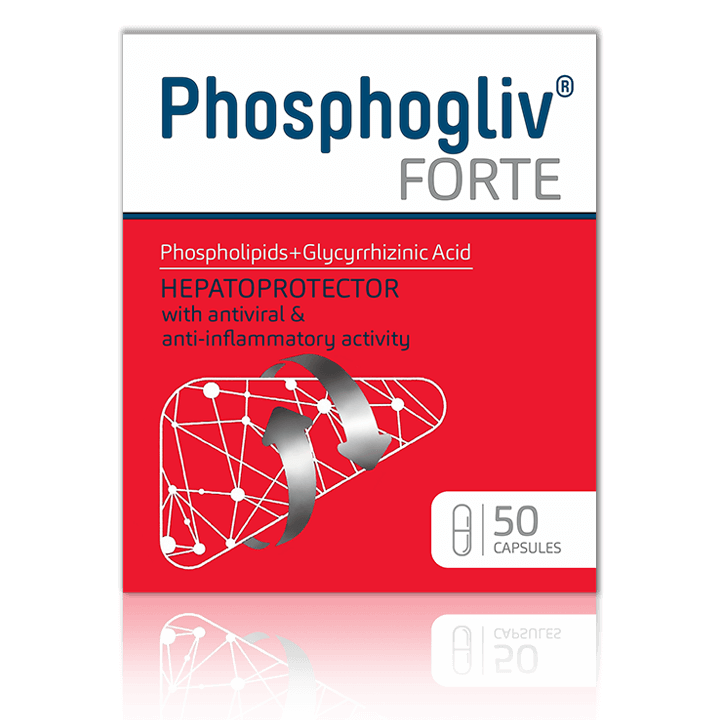Phosphogliv® Forte Instruction
International Non-Proprietary Name (INN): phospholipids + glycyrrhizic acid
Dosage form: capsules
Structure
In 1 capsule:
Active ingredients: phospholipids (Lipoid PPL-400) 400 mg, phosphatidylcholine (the main component 73–79%) 300 mg, sodium glycyrrhizinate (trisodium salt of glycyrrhizic acid) 65 mg;
Excipients: butylhydroxytoluene 0.1 mg, ethyl alcohol of “lux” or “extra” grade (ethanol) 12 mg, sunflower or corn oil 22.9 mg;
The composition of the capsule shell: titanium dioxide, red iron oxide, black iron oxide, yellow iron oxide, gelatin.
Description
Hard gelatin capsules No. 0. The capsule body and cap are brown. The content of the capsule is an oily pasty mass with a faint specific smell, its color varies from light yellow to orange-brown.
Pharmacological classification: hepatoprotective agent
ATC code: A05BA
Pharmacological action: anti-inflammatory, hepatoprotective, metabolic, membrane-stabilizing

Pharmacodynamics
Combination medicine. It has a membrane-stabilizing, hepatoprotective and antiviral effect.
Phosphatidylcholine (the main component of phospholipids) is the main structural element of the cell and intracellular membranes; it is able to restore their structure and function upon the damage, providing a cytoprotective effect. It normalizes protein and lipid metabolism, prevents the loss of enzymes and other active substances by hepatocytes. It restores the detoxification function of the liver, inhibits the formation of connective tissue, reducing the risk of liver fibrosis and cirrhosis.
Glycyrate (glycyrrhizic acid and salts) has an anti-inflammatory effect; it inhibits the reproduction of viruses in the liver and other organs by stimulating the production of interferons, increasing phagocytosis and the activity of natural killer cells. It has a hepatoprotective effect due to antioxidant and membrane-stabilizing activity. It potentiates the action of endogenous glucocorticosteroids, providing an anti-inflammatory and anti-allergic effect in non-infectious liver lesions. In the case of skin lesions, the membrane-stabilizing and anti-inflammatory action of the medication components is known to limit the spread of the process and it contributes to the regression of the disease.
Pharmacokinetics
Phosphatidylcholine
More than 90% of the phospholipids taken orally are absorbed in the small intestine. Most of them are split by phospholipase A to 1-acetyl-lysophosphatidylcholine, 50% of which undergoes reverse acetylation to polyunsaturated phosphatidylcholine during absorption in the intestinal mucosa. Polyunsaturated phosphatidylcholine enters the bloodstream with the lymph flow, from where it mainly enters the liver in the form associated with high-density lipoproteins. Pharmacokinetics in humans has been studied using dilenoleylphosphatidylcholine with a radioactive label 3H (choline part) and 14C (residue of linoleic acid). The maximum concentration of 3H is reached after 6–24 hours, amounting to 19.9% of the prescribed dose; 14C – after 4–12 hours, amounting to 27.9%. The half-life of the choline component is 66 hours, the residue of linoleic acid – 32 hours. There is 2% of 3H and 4.5% of 14C in feces, in urine – 6% of 3H, and a minimum amount of 14C. More than 90% of both isotopes are absorbed in the intestine.
Glycyrrhizin acid
Under the influence of the β-glucuronidase enzyme produced by bacteria of the normal microflora, an active metabolite – β-glycyrrhizic acid – is formed from glycyrrhizic acid in the intestine after an oral administration, it is then absorbed into the systemic blood flow. In blood, β-glycyrrhizic acid binds to albumin and is almost completely transported to the liver. The release of β-glycyrrhizic acid occurs predominantly with bile, in residual quantities – with urine. According to experimental data, phospholipids improve the lipophilic properties of glycyrrhizic acid, increasing its intensity and absorption rate by more than 2 times.
Intended uses
- fatty liver disease (fatty hepatosis);
- alcoholic, toxic, including drug-induced, liver injury;
- as part of the complex therapy of viral hepatitis, cirrhosis, psoriasis.
Contraindications
- antiphospholipid syndrome;
- use in patients with intolerance to corn or corn products (the component being a part of excipients may contain corn oil);
- hypersensitivity to the drug components;
- pregnancy, the period of breastfeeding;
- children under 12 years old.
With caution: Portal hypertension, arterial hypertension.
Dosage and administration
The drug is taken orally during meals, with a small amount of liquid. Age dosages:
- adults: 1-2 capsules 3 times a day;
- children over 12 years old: 1 capsule 3 times a day.
The duration of the course of treatment is determined by the doctor.
Precaution
If there is a retention of sodium and fluid or hypokalemia, it is necessary to reduce the dose of the drug and/or prescribe Spironolactone 50–100 mg, depending on the severity of the symptoms.
Side effects
Allergic reactions
Skin rash, difficulty in nasal breathing, conjunctivitis, cough.
Cardiovascular system
Transient increase in blood pressure, peripheral edema.
Digestive system
Dyspeptic symptoms (burping, nausea, bloating), a feeling of discomfort in the stomach.
If these symptoms occur, stop taking the drug and consult the doctor.
Overdose
Symptoms
Sodium and fluid retention in the body manifested in peripheral edema and increased blood pressure; hyponatremia.
Treatment
Depending on the severity of the symptoms of an overdose, it is necessary to reduce the dose of the drug and/or prescribe Spironolactone (50–100 mg per day).
Interaction with other drugs
Glycyrrhizic acid is a synergist of corticosteroid hormones, it enhances and prolongs their effect.
Pregnancy and lactation
The drug is contraindicated during pregnancy and breastfeeding (data on efficacy and safety are insufficient).
Influence on the ability to drive vehicles and operate mechanisms
The use of the drug does not affect the ability to drive vehicles and engage in other potentially dangerous activities that require the increased concentration of attention and speed of psychomotor reactions.
Storage conditions
Store in a dry place, at a temperature not exceeding 25°C (77°F). Keep out of the reach of children.
Shelf life
3 years. Do not use beyond the expiration date.
Manufacturer
Pharmstandard, Russia. https://pharmstd.com/